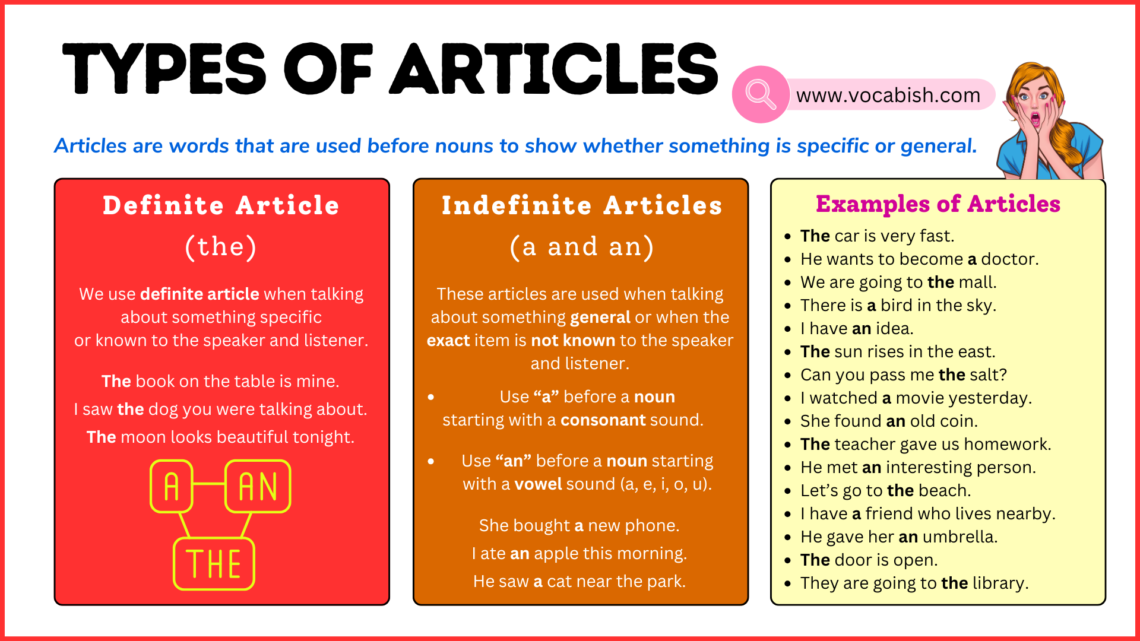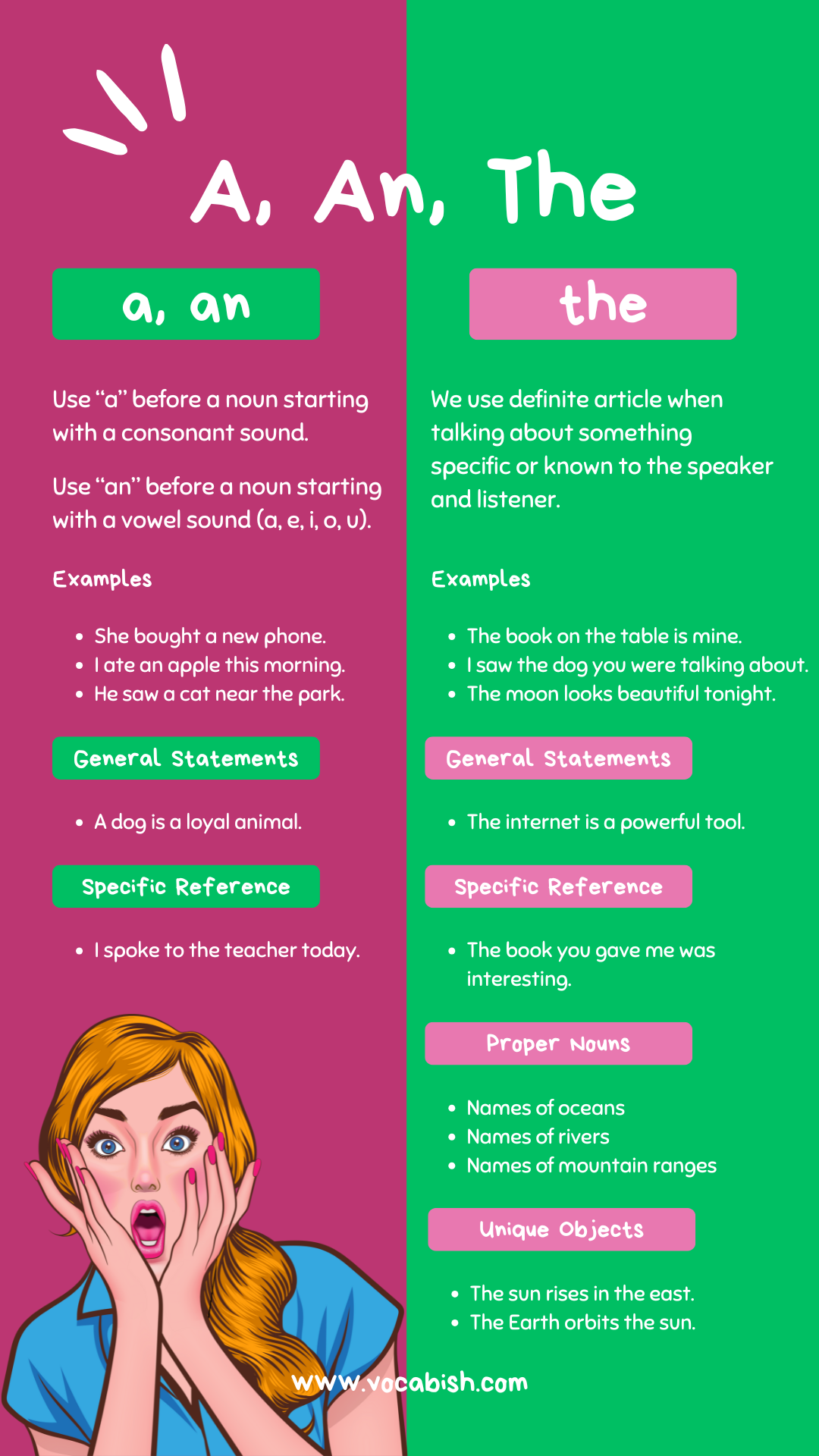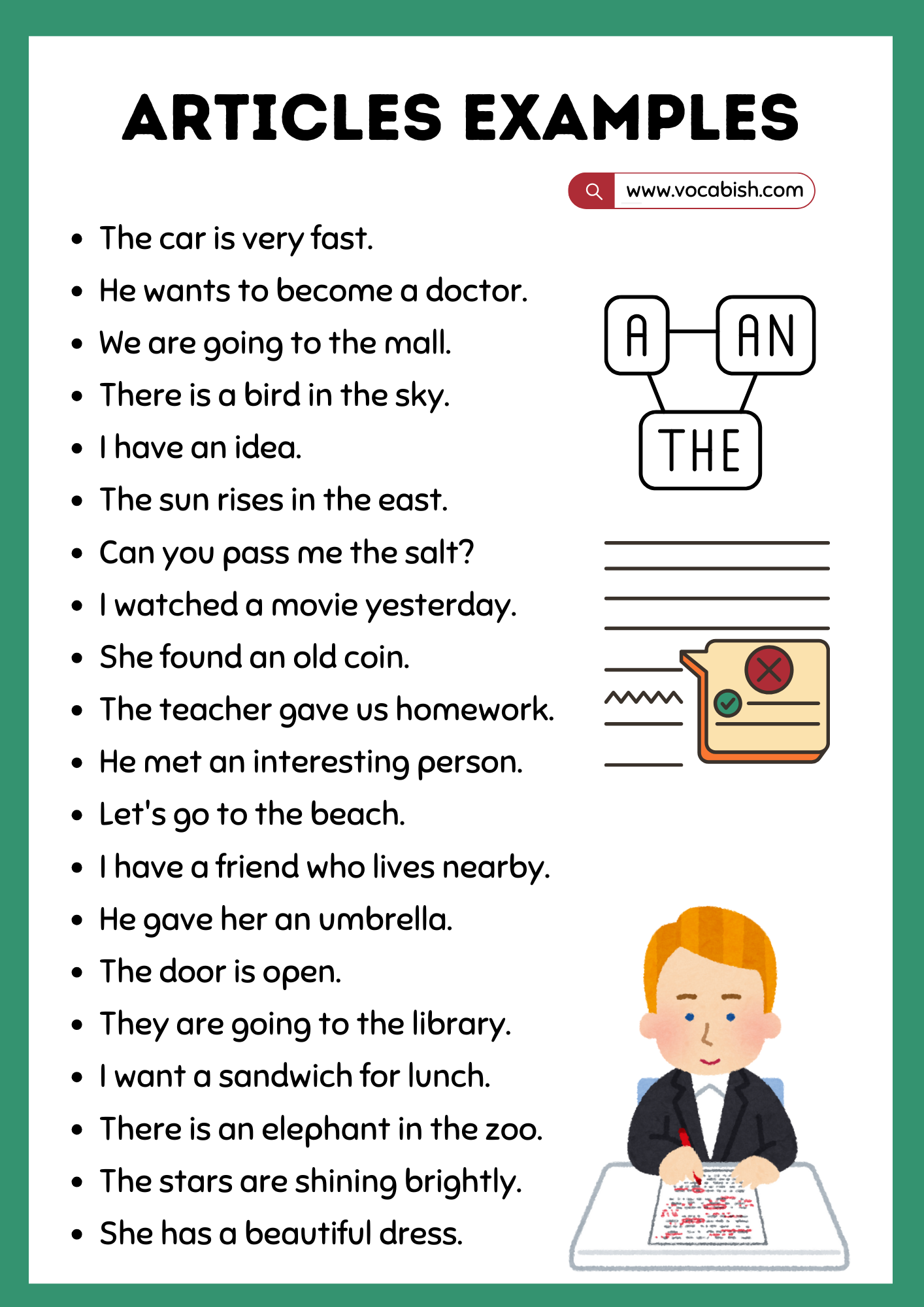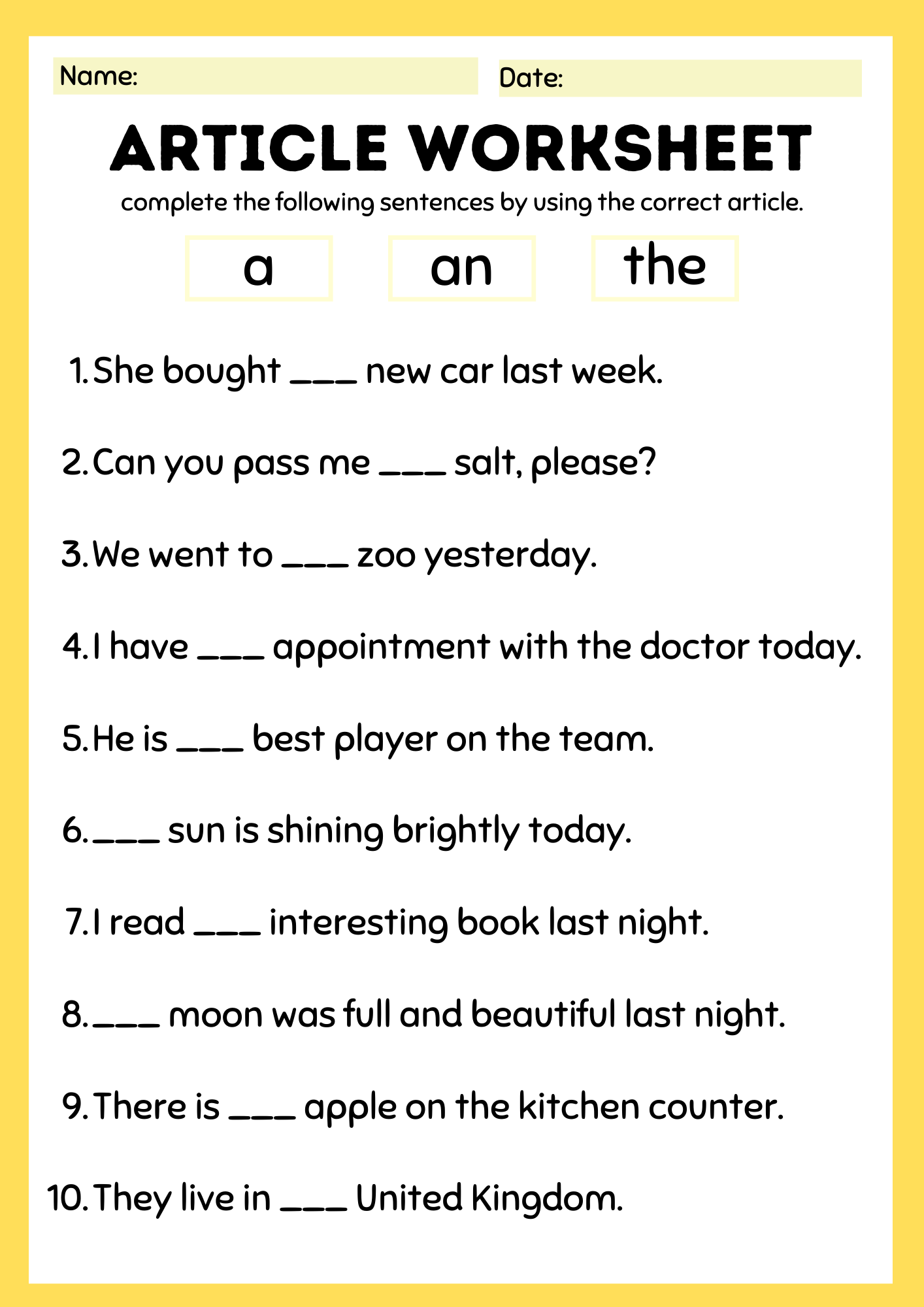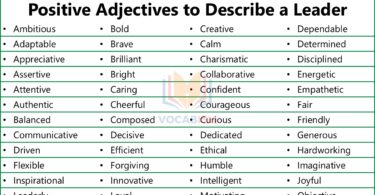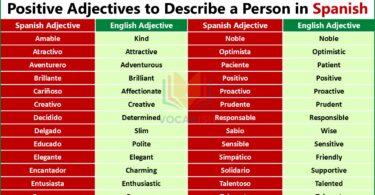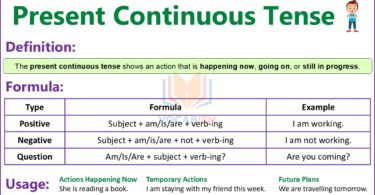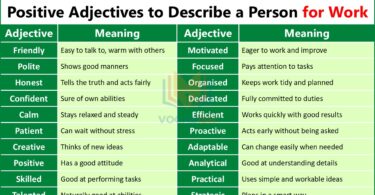In this lesson, we are going to learn about articles in English. Articles are small but important words that we use before nouns to show if we are talking about something specific or general. We’ll cover the two types of articles, definite and indefinite, with simple examples that help you understand when and how to use them. By the end of this lesson, you’ll know the common articles, how to form sentences with them, and practice using articles correctly.
What Are Articles?
Articles are words that are used before nouns to show whether something is specific or general. The main articles in English are “a,” “an,” and “the.”
Types of Articles
Definite Article (“the”):
We use definite article when talking about something specific or known to the speaker and listener.
Examples:
- The book on the table is mine.
- I saw the dog you were talking about.
- The moon looks beautiful tonight.
- The cat is sleeping on the sofa. (a specific cat, both speaker and listener know which one)
- I went to the park yesterday. (a specific park that is known or mentioned)
- Look at the stars in the sky. (refers to specific stars visible to everyone)
Indefinite Articles (“a” and “an”):
These articles are used when talking about something general or when the exact item is not known to the speaker and listener.
- Use “a” before a noun starting with a consonant sound.
- Use “an” before a noun starting with a vowel sound (a, e, i, o, u).
Examples:
- She bought a new phone.
- I ate an apple this morning.
- He saw a cat near the park.
- She is reading a book. (any book, not a specific one)
- He saw a bird flying. (any bird, not specified)
- I ate an orange. (any orange, not a specific one)
- She met an old friend. (someone from the past, but not specific)
General Usage Rules of Articles:
Use “the” when talking about something that is one of a kind or specific:
- The sun is bright today. (there is only one sun)
- The Earth is our planet. (there is only one Earth)
Use “a” or “an” when referring to any one item from a group:
- I need a pen. (any pen, not a specific one)
- He wants to eat an apple. (any apple, not specified)
By understanding how to use articles, you can improve your communication and make your sentences clearer and more accurate.
Articles in Different Contexts and Accents
Articles in English are used across various contexts to modify nouns. While the general rules for using “a,” “an,” and “the” remain consistent, their pronunciation may vary in different accents. Below, we’ll explore how articles are used in different contexts, along with a focus on accent differences.
Use of Articles in Different Contexts
General Statements:
Articles help in making generalizations about things or people.
Examples:
- A dog is a loyal animal. (talking about dogs in general)
- The internet is a powerful tool. (a general statement about the internet)
Specific Reference: When referring to specific things that both the speaker and the listener are aware of.
Examples:
- I spoke to the teacher today. (both know which teacher)
- The book you gave me was interesting. (a specific book)
First and Second Mentions:
Use “a” or “an” the first time you mention something and “the” when you mention it again.
Examples:
- I saw a movie yesterday. The movie was amazing!
- They bought an old car. The car runs well.
Proper Nouns:
Usually, articles are not used with proper nouns (names of people or places), but there are exceptions:
Use “the” before:
- Names of oceans (e.g., the Atlantic Ocean)
- Names of rivers (e.g., the Nile River)
- Names of mountain ranges (e.g., the Himalayas)
- Famous buildings or landmarks (e.g., the Eiffel Tower)
Unique Objects:
Use “the” when referring to one-of-a-kind objects.
Examples:
- The sun rises in the east.
- The Earth orbits the sun.
Countries and Cities:
Most countries do not take an article (e.g., France, India), but some do:
Example:
- The United States, the Netherlands.
Accent Differences in the Pronunciation of Articles
While the usage of articles remains the same across different English dialects, their pronunciation can vary depending on the accent.
American vs. British Accent:
In American English, the article “the” is often pronounced with a short “uh” sound when it comes before consonants (e.g., “thuh dog”) and as “thee” when it comes before vowels (e.g., “thee apple”).
Examples:
- “thuh dog” (before a consonant)
- “thee apple” (before a vowel)
In British English, the pronunciation is quite similar but may sound slightly more formal, with a more distinct “thee” sound even before consonants in certain contexts.
Examples:
- “thee dog” (a more formal setting or emphasis)
- “thee apple” (before a vowel)
Australian Accent:
The Australian accent follows similar rules to British English for article pronunciation but tends to have a more relaxed intonation, with “the” often pronounced in a shorter, softer manner (e.g., “thuh” dog, “thee” apple).
Regional Variations in Pronunciation:
In some regional dialects of English, particularly in rural or non-standard varieties, articles may be dropped or pronounced differently. For example, in some Northern English dialects, the article “the” might be shortened to a sound like “t’” in casual speech.
Understanding the usage of articles in different contexts and how they sound in various accents will help English learners apply them more confidently in speaking and writing.
Example of Articles
In this section, you will learn the example sentences and list of articles that are used in the English language:
- The car is very fast.
- He wants to become a doctor.
- We are going to the mall.
- There is a bird in the sky.
- I have an idea.
- The sun rises in the east.
- Can you pass me the salt?
- I watched a movie yesterday.
- She found an old coin.
- The teacher gave us homework.
- He met an interesting person.
- Let’s go to the beach.
- I have a friend who lives nearby.
- He gave her an umbrella.
- The door is open.
- They are going to the library.
- I want a sandwich for lunch.
- There is an elephant in the zoo.
- The stars are shining brightly.
- She has a beautiful dress.
FAQs about Articles
What are articles in English grammar?
Articles are words (a, an, the) used before nouns to define whether the noun is specific or general.
What are the two types of articles?
The two types are Definite Article (the) and Indefinite Articles (a, an).
When do we use the article “a”?
Use “a” before a singular noun starting with a consonant sound, e.g., a dog, a book.
When do we use the article “an”?
Use “an” before a singular noun starting with a vowel sound, e.g., an apple, an hour.
What is the main rule for using “the”?
Use “the” when talking about something specific or already known, e.g., the sun, the teacher.
Practice Exercise about Articles
Fill in the blanks with a, an, or the:
- She bought ___ new car last week.
- Can you pass me ___ salt, please?
- We went to ___ zoo yesterday.
- I have ___ appointment with the doctor today.
- He is ___ best player on the team.
- ___ sun is shining brightly today.
- I read ___ interesting book last night.
- ___ moon was full and beautiful last night.
- There is ___ apple on the kitchen counter.
- They live in ___ United Kingdom.
Answers:
- She bought a new car last week.
- Can you pass me the salt, please?
- We went to the Zoo yesterday.
- I have an appointment with the doctor today.
- He is the best player on the team.
- The sun is shining brightly today.
- I read an interesting book last night.
- The moon was full and beautiful last night.
- There is an apple on the kitchen counter.
- They live in the United Kingdom.
Read More

